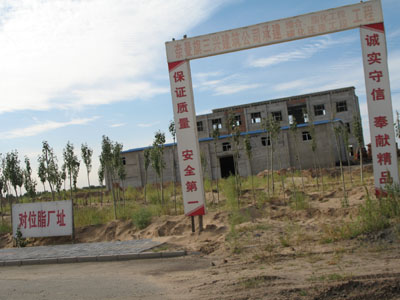| SMHRIC |
| April 6, 2012 |
| New York |
 |
| para-base-ester factory site in Naiman Banner (SMHRIC photos) |
Following three days of protests by Mongolians of Tulee Gachaa (gachaa is equivalent to village), Naiman Banner (Banner is equivalent to county) of eastern Southern (Inner) Mongolia, the Chinese authorities in Naiman Banner finally freed all twenty two detainees who were arrested while attempting to stop the bulldozer of a Chinese state-run forestry company from leveling and occupying the Gachaa’s land.
However, the authorities have continued their repression by initiating investigations of individuals who gave interviews to foreign and domestic news agencies or otherwise spread word of the protests. At least one local Mongolian who lived outside the Gachaa was arrested by police on April 6, 2012 accused of “defaming the state”. Several others are being investigated for suspicion of communicating with foreign reporters.
“The Deputy Governor of Tongliao Municipality surnamed Sun visited our Gachaa yesterday along with more than twenty officials from the Banner Government,” a Mongolian from the Gachaa told the Southern Mongolian Human Rights Information Center (SMHRIC) over the phone, “the Deputy Governor promised to punish those who beat and tortured the Mongolian protesters and detainees.”
According to this villager, the officials also promised to investigate the land expropriation. “This is our land, there is no need to carry out a so-called ‘investigation’. What we need is our land, compensation for beating and other losses,” he added.
“Blocking information and isolating the village from the outside world seems to be the top priority of the officials,” a college student from Tulee Gachaa who asked to remain anonymous said in an email communication to SMHRIC, “they are, on the one hand, trying to punish those who put the word out about the protests in the village to foreign news media. On the other hand, the officials are deploying State Security agents in each household to prevent any information leaking to outsiders.”
“The entire Gachaa with more than 300 people protested in solidarity, and refused to accept this outrageous illegal act,” the college student added.
“Officials from the Municipality and the Banner are now threatening us with the so-called ‘defamation of state’ accusation. I don’t think there is a crime called ‘defaming the state’,” another Mongolian villager told SMHRIC over the phone ignoring the authorities’ surveillance, “even if there is such a crime, the criminal perpetrators are not us Mongolians, but those corrupt officials and police who illegally took our land and beat our protestors.”
Despite the tight control over the flow of information on the protest over the internet, Mongolian students of Tongliao Municipality are rallying the Mongolians to support the Tulee Gachaa protesters. A student group named “Free Association of Mongolian Students” issued an appeal online and called on all Mongolian students, herders and farmers to join together to take to the streets to defend their rights in support of Tulee Gachaa Mongolians.
Although the authorities’ concerns have shifted to stopping the flow of information and setting an example of the consequences of spreading information deemed ‘defamation of the state’, such repressive measures have led to calls for further protests by the Mongols throughout the region.







